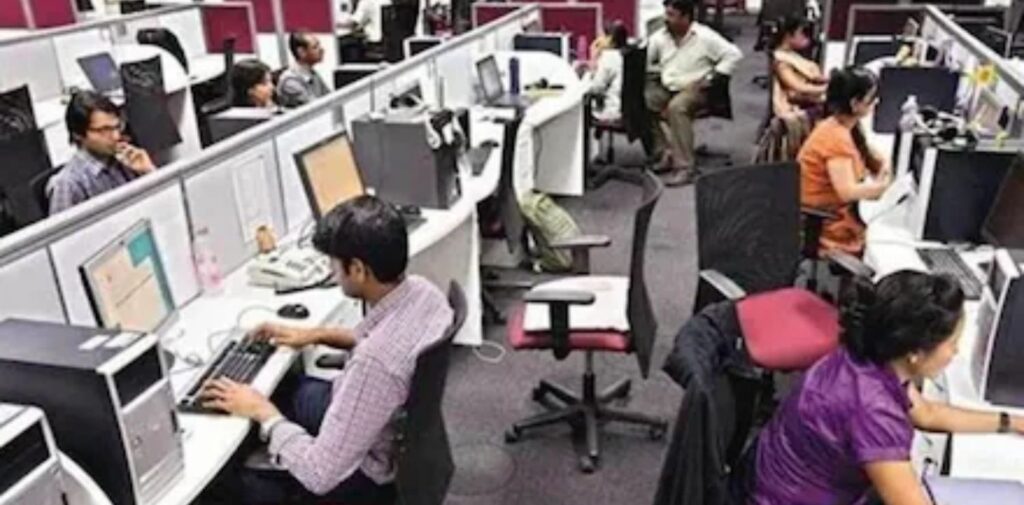India’s Information Technology (IT) industry has been one of the most important and fastest-growing sectors of the economy in the last few decades. From small beginnings in the 1990s, it has grown into a giant industry that contributes billions of dollars to India’s GDP, creates millions of jobs, and puts India on the global map. But, like everything else, it has both positive and negative effects. In this article, we will look at how India’s IT industry has helped the economy grow and also the challenges it brings with it.

What is India’s IT Industry?
India’s IT industry includes businesses that provide services related to technology, such as computer software development, programming, cybersecurity, and customer support services for global companies. IT companies also provide services like IT consulting, cloud computing, and data management. Some of the most famous IT companies in India are Infosys, TCS, Wipro, and HCL.
The IT industry has not only helped India become an important player in the global economy but has also made technology more accessible to people all over the country. In fact, the IT industry is often called the “back office” of the world, because it provides services to companies around the globe.

Positive Impacts of India’s IT Industry on the Economy
India’s IT industry has brought many benefits to the country. Let’s look at some of the main positive impacts:
- Massive Economic Growth: The IT industry has been a major contributor to India’s economic growth. Since the 1990s, when India started focusing on technology, the IT sector has grown rapidly. It now contributes a huge amount to the country’s economy. In fact, the IT industry is one of the biggest industries in India, providing billions of dollars in revenue. This growth has made India one of the largest economies in the world.
- Job Creation: The IT industry has created millions of jobs, both directly and indirectly. Millions of young people in India work in software development, customer support, and tech consulting. IT companies also hire people in marketing, human resources, finance, and administration. Because of the IT sector, many students with engineering, computer science, and business backgrounds have found stable and well-paying jobs. Moreover, the growth of the IT industry has led to the creation of many other jobs in fields like real estate, retail, and education. People from all over India, including small towns and villages, have moved to cities to work in the IT sector, which has helped reduce unemployment.
- Boosting India’s Global Image: India’s IT industry has helped change the world’s view of India. Today, when people think of India, they don’t just think of its rich culture or history—they also think of India as a hub for technology and innovation. India is known for its skilled workforce, and many global companies trust Indian IT firms to handle their technology needs. The success of India’s IT industry has also encouraged foreign companies to set up offices in India. These companies bring in investments, technology, and new ideas, which help improve India’s economy even more. The rise of India’s IT sector has turned the country into a key player in the global technology market.
- Development of Infrastructure: With the rise of the IT industry, cities like Bengaluru, Hyderabad, Pune, and Chennai have developed into modern hubs for technology. These cities have seen growth in infrastructure such as roads, public transport, schools, and hospitals. The IT industry has helped improve the quality of life for many people living in these cities by providing better services and creating opportunities for local businesses to grow.
- Focus on Education and Skills Development: The IT industry has also led to a focus on education and skill development in India. Many universities and colleges have started offering courses related to computer science, engineering, and technology. The IT industry has encouraged young people to pursue education in these fields, which has raised the level of education in the country. Through various training programs and initiatives, the IT sector has also helped millions of people acquire new skills that are needed in today’s digital world. This has made India a global leader in the technology field.

Negative Impacts of India’s IT Industry on the Economy
While the IT industry has brought many benefits, it also comes with some challenges. Let’s explore the negative impacts:
- Unequal Growth and Regional Disparities: One of the biggest challenges of India’s IT sector is that its growth has not been equally spread across the country. While cities like Bengaluru, Hyderabad, and Pune have seen huge benefits from the IT industry, many rural areas and small towns have not experienced the same level of development. The wealth created by the IT industry is concentrated in a few cities, leaving many areas behind. This unequal growth has led to a rise in migration from rural areas to cities. Many people move to big cities to find jobs in the IT sector, which has caused overcrowding and put a strain on resources like housing, water, and transportation.
- Job Security and Working Conditions: While the IT industry has created many jobs, these jobs are not always secure. Many IT workers face challenges like long working hours, high levels of stress, and contract-based employment. These workers do not always have the job security or benefits that other workers in traditional industries might have. This can make their work life difficult and uncertain. Additionally, the rise of automation and artificial intelligence is slowly reducing the need for certain types of jobs in the IT sector. As machines and software become more advanced, some jobs may be replaced by technology, leaving workers without employment.
- Overdependence on a Single Sector: Another downside of India’s IT industry is the overdependence on one sector for economic growth. The IT industry has become such a big part of India’s economy that any problems in the industry—like a slowdown in demand or the loss of business to other countries—could affect the entire economy. It’s important for India to diversify its economy and not rely too much on one industry.
- Environmental Concerns: The growth of IT parks, offices, and cities has also had some environmental consequences. As more IT companies are set up, more land is used for buildings and infrastructure. This has led to deforestation and a loss of green spaces. Additionally, the demand for electricity has increased, leading to a rise in carbon emissions and pollution in certain areas. While technology helps in many ways, it also creates environmental challenges that need to be addressed.
- Skilled Labor Shortage: Although India has a large number of young, talented individuals who can work in the IT sector, the rapid growth of the industry has created a gap between the demand for skilled workers and the available supply. Many companies struggle to find workers with the right skills and knowledge, especially in advanced technologies like artificial intelligence, machine learning, and data science. This shortage of skilled workers can slow down the growth of the IT industry and limit India’s potential in the technology sector.
Conclusion: Boon or Bane?
So, is India’s IT industry a boon or a bane for the economy? The answer is that it is both—a boon in many ways but also a bane in others.
On one hand, the IT industry has contributed enormously to India’s economic growth, job creation, and global standing. It has transformed cities, provided new opportunities, and helped improve education and infrastructure. On the other hand, it has also created challenges such as regional inequality, job insecurity, environmental concerns, and overdependence on one industry.
The key to making the IT sector a greater boon for India lies in addressing these challenges. By ensuring that the benefits of IT reach all parts of the country, improving working conditions, and diversifying the economy, India can continue to thrive in the digital age while minimizing the negative impacts.
In the end, the IT industry is a powerful force for India’s economy, and its future looks bright, but it must be handled carefully and responsibly to ensure that it benefits everyone.




